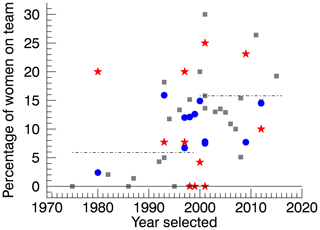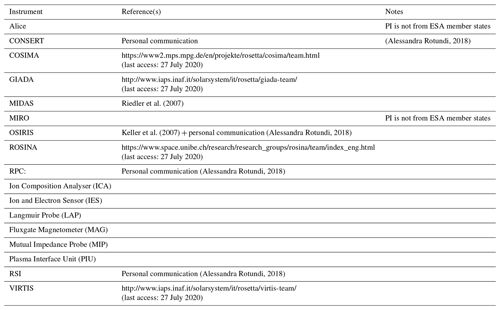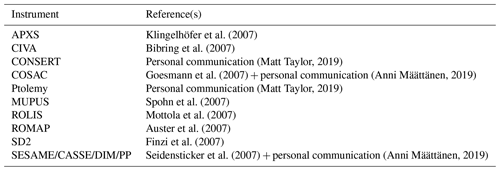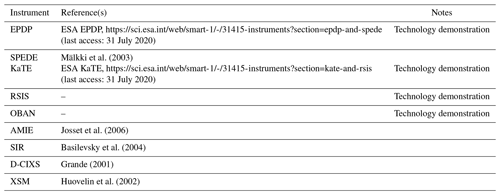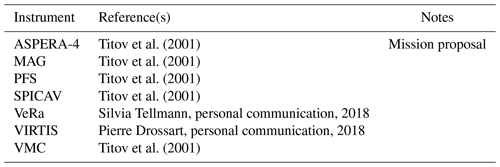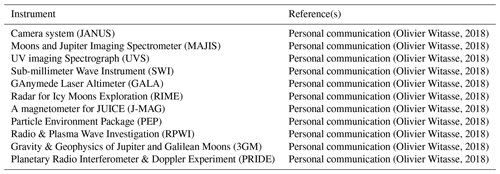Participation of women scientists in ESA solar system missions: a historical trend
Arianna Piccialli
Julie A. Rathbun
Anny-Chantal Levasseur-Regourd
Anni Määttänen
Anna Milillo
Miriam Rengel
Alessandra Rotundi
Matt Taylor
Olivier Witasse
Francesca Altieri
Pierre Drossart
Ann Carine Vandaele
We analyzed the participation of women scientists in 10 ESA (European Space Agency) Solar System missions over a period of 38 years. Being part of a spacecraft mission science team can be considered a proxy to measure the “success” in the field. Participation of women in PI (Principal Investigators) teams varied between 4 % and 25 %, with several missions with no women as PI. The percentage of female scientists as Co-I (Co-Investigators) is always less than 16 %. This number is lower than the percentage of women in the International Astronomical Union from all ESA's Member State (24 %), which can give us an indication of the percentage of women in the field.
We encountered many difficulties to gather the data for this study. The list of team members were not always easily accessible. An additional difficulty was to determine the percentage of female scientists in planetary science in Europe. We would like to encourage the planetary community as a whole, as well as international organizations, universities and societies to continuously gather statistics over many years. Detailed statistics are only the first step to closely monitor the development of achievement gaps and initiate measures to tackle potential causes of inequity, leading to gender inequalities in STEM careers.
- Article
(1762 KB) - Full-text XML
- BibTeX
- EndNote
Numerous analyses have revealed that women are under-represented in science, technology, engineering and mathematics (STEM) careers. Many factors have been cited as potential contributors to this. For example, Dutt et al. (2016) suggested that women are significantly less likely to receive excellent recommendation letters than male applicants in the geosciences. Lerback and Hanson (2017) presented evidence that women of all ages have fewer opportunities to take part in peer reviews for journals on geosciences. Moreover, men are more likely invited to give a colloquium than women at prestigious universities and at symposia (Nittrouer et al., 2018; Schroeder et al., 2013).
In astronomy, similar studies indicate the existence of gender biases and barriers to inclusion (Tuttle, 2017). Female astronomers are leaving the academic labor market at a rate that is 3–4 times higher than male astronomers (Flaherty, 2018). Caplar et al. (2017) applied machine-learning techniques accounting for non-gender specific attributes to a sample of more than 200,000 publications over a 65-year period. In their study, they found that astronomy papers led by women receive 10 % fewer citations than those led by men. Several analysis carried out for a variety of organizations (i.e. the Hubble Space Telescope, the European Southern Observatory, and the National Radio Astronomy Observatory) proposal selection processes revealed that proposals submitted by female PIs show a significantly lower probability of being allocated telescope time (Reid, 2014; Lonsdale et al., 2016; Patat, 2016; Spekkens et al., 2018). A review of seven of the prizes and awards given out by the American Astronomical Society (AAS) for ten or more years for contributions to astronomical research, instrumentation or education shows that the percentage of female recipients remains below 10 %, lower than the fraction of female AAS members (Knezek, 2017). Women ask systematically less questions at astronomical meetings (Davenport et al., 2014; Pritchard et al., 2014; Schmidt and Davenport, 2017).
A recent study by Rathbun (2017) analyzed the participation of female scientists in US planetary science missions as a measure of success in the field. Their analysis shows women scientists to be consistently under-represented on the science teams of NASA's robotic planetary spacecraft missions.
Inspired by these findings, we carried out a study of the participation of women scientists in ESA Solar System missions and discuss how this trend changed over time. Along with a team of volunteers, we counted the science team members of 10 ESA Solar System missions over a period of 38 years and determined the percentage of women on each team.
We describe the method followed for our analysis in Sect. 2. Results are reviewed in Sect. 3. We examined the percentage of women in planetary science in Europe in Sect. 4 and we present the conclusions in Sect. 6.
We limited our study to ESA Solar System missions as listed on the ESA Science & Technology web-page (see Table 1 and https://sci.esa.int/web/home/-/51459-missions, last access: 27 July 2020).
A typical ESA Solar System mission team consists of a Principal Investigator (PI) for every instrument included in the payload; in few cases, there are also Co-Principal Investigators (Co-PIs), counted here as PIs. PIs are in charge of proposing the space experiment, with full responsibility for getting funds, building, testing, and analyzing its scientific data. Each instrument team includes moreover several Co-Investigators (Co-Is). A scientist can be Co-Is on more than one instrument within one ESA's mission, in such a case, she/he was counted only once. Team members affiliated to an institution not part of the 22 ESA's Member States were not counted. It should be recalled that in 1980 – at the time of the first Solar System mission's selection – there were only 11 ESA's Member States.
For this study, we counted separately the PIs (including the Co-PIs) and the Co-Is for each ESA mission.
We followed the same methodology described in Rathbun et al. (2015), for consistency with their study. Their goal was to consider only original team scientists (not engineers or members of project management nor students or postdocs) in order to compare it to the composition of the field at that time. Being part of an original spacecraft team can be considered as a measure of success. Moreover, for both NASA and ESA missions, keeping track of changes in science team membership was just too difficult, as often changes are not generally released publicly. We, therefore, aimed to consider only the original team scientists. However, this was not always possible, as often new members are added over time, and the original team composition was lost.
PI names can be easily found in ESA missions web-pages, however, often only the current PI name is indicated. For each team, in order to find the original team members at the time when the mission was selected, we searched team web pages, published articles and when possible, we directly contacted the Principal Investigators and Project Scientists. In order to determine gender, we relied on personal knowledge, first name or photographs. For practical reasons, gender identities outside the male/female binary were not considered in the analysis. In the future, we would like to include studies of self-reported gender that include multiple identities (Zellner et al., 2019). In Appendix A, we indicate the references we used for each ESA mission and each instrument considered in this study.
Table 1 presents the percentage of women PIs and Co-Is on ESA Solar System missions. Participation of women in PI teams varied between 4 % and 25 %, with several missions with no women at all as PI. Percentages do not follow any obvious trend with time (Fig. 1).
Table 1List of ESA's Solar System missions, ordered by year of selection. The target of the mission and the percentage of women PI and Co-I for each mission at the time when the mission was selected is indicated.


Figure 1Number of PIs (Principal Investigators) on ESA planetary missions as a function of time. The x axis indicates the year the science mission was selected. Each bar indicates the numbers of men (purple) and women (orange) on the originally selected team on the year the team was selected. The percentage of women for each mission is indicated within parenthesis.
The percentage of women as Co-Is is always less than 16 % (Fig. 2). In addition, we could analyze the evolution of the PI team members for two missions: Rosetta and Cluster. For the Rosetta mission, the ratio of female to male PIs changed from 1∕13 (in 1993) to 3∕13 (in 2019). The PI team of the Cluster mission has been subject to higher fluctuations: 2∕11 (in 1997), 3∕11 (2010), and 1∕11 (in 2014).

Figure 2As Fig. 1, but showing the number of Co-Is (Co-Investigators) team members on ESA planetary missions.
We compared our results with NASA statistics. Participation of women in NASA spacecraft science teams varies from none to just over 30 % (Rathbun, 2017). The percentage has been increasing. However, this increase is more similar to a step function than a linear increase, with the pre-2000 average at 5.7 % and post-2000 at 15.8 % (illustrated by dash-dot lines in the Fig. 3). This is well below the percentage of women in the field in the US, which has grown from 20 % to 30 % over the same time range.
Figure 3 also includes the percentage of women PIs and Co-Is on ESA missions to compare to the percentage on NASA missions. The ESA data are consistent with the NASA data, including the jump around the year 2000.
To put the previous statistics in the right context, it is important to compare the percentage of women in ESA Solar System missions to the percentage of women in planetary science in Europe. This has proved difficult because there are few global statistics over Europe and it is not always easy to gather these numbers for each European country.
As a preliminary analysis, we investigated the percentage of women in the European Geosciences Union (EGU) and in the International Astronomical Union (IAU). Planetary science is a cross-discipline field including aspects of both astronomy and Earth science, therefore, EGU's and IAU's demographics can give a partial indication of the percentage of women in planetary science in Europe.
The European Geosciences Union (EGU) is the leading organization for Earth, planetary and space science research in Europe. In 2015, 69 % of members were male and 31 % were female, with the difference between male and female member proportions more pronounced for early career scientists (https://blogs.egu.eu/geolog/2016/06/24/gender-equality-in-the-geosciences-is-it-a-numbers-game/, last access: 6 July 2020).
The IAU is an international organization with participation from 68 countries that covers the main areas of astronomy, including planetary science. We limited our analysis only to ESA's 22 Member States.
The percentage of women in the IAU from all ESA's Member State is 24 % (the IAU membership of US is 16 %). This number varies for each country between 13 % in Sweden and Switzerland (notice that Luxembourg has one single male individual member in the IAU) and 35 % in Romania (Fig. 4).

Figure 4Percentage of women in the International Astronomical Union (IAU) from all ESA's Member State. Colorbar indicates the percentage women for each country.
Figure 5 shows how this percentage has changed from triennium to triennium between 1997 and 2009 for some ESA's member states as reported by Cesarsky and Walker (2010). The percentage of women in IAU has increased constantly with the exception of Denmark, France, Hungary, and Spain, where the percentage has been slightly decreasing over time.
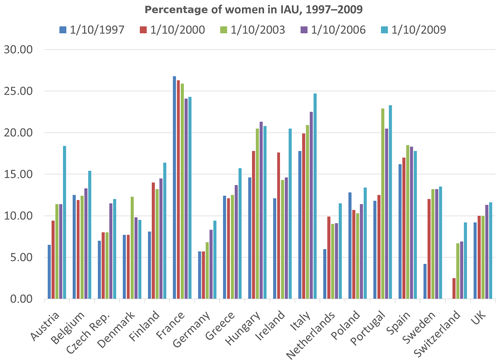
Figure 5The evolution of women's percentage in the IAU from ESA's Member State over the period 1997–2009.
We then focused on the demographics of two IAU's Divisions more connected to planetary science: Division E (Sun and Heliosphere) and Division F (Planetary Systems and Astrobiology). The percentage of women in Division E is 22 % (female: 274, male: 1254, and other: 1), while the percentage of women in Division F is 21 % (female: 430, male: 2076, and other: 2) (Madeleine Smith-Spanier, personal communication, 2020). These statistics need to be taken cautiously. Since the recent Divisions started in 2012, the numbers above are the total numbers of members registered in the database between 2012 and now, without taking in account if a member is still active today. Moreover, they cover all IAU's Member States and are not limited to ESA's Member States. Finally, it is important to notice that not all planetary scientists in Europe are members of IAU, therefore most probably these values underestimate the number of women in the field.
For example, in 2019, 27 % of Italy members of the IAU are female. In an earlier study, Matteucci and Gratton (2014) reported figures for Italy, indicating that, in 2014, women in INAF (Istituto Nazionale di Astrofisica) made up 32 % of the research staff (289 out of 908) and 40 % of the technical/administrative staff (173 out of 433). The percentage was slightly lower among the permanent research staff (180 out of 599, about 30 %). The presence of women was lower in the Universities (27 out of 161, about 17 %, among staff).
14 % of UK members of the IAU are female. In 2016 the Royal Astronomical Society commissioned a general demographic survey of the UK astronomy and geophysics research community (McWhinnie, 2017). Their results show that 21 % of professors, 22 % of Senior Lecturers/Readers and 27 % of lecturers in Solar System science are female. Comparing the data for 2010 and 2014 shows that in most staff grade the proportion of staff who are female has risen (Massey, 2015).
26 % of IAU members in France are women. We have also tried to estimate the percentage of women in planetology in France relying in particular on the statistics made by the National Planetology Program (PNP, Programme national de planétologie: Alessandro Morbidelli, personal communication, 2018). According to the statistics made based on lists of permanent research personnel active in planetary science in French research laboratories, about 22 % are women. We also compared this number to two separate studies, conducted by Bot and Buat (2018, 2020). They collected the statistics on women among university teachers in astronomy and astrophysics (section 34 of the Conseil national des universités) and compared them to the statistics among other permanent research personnel: CNRS (Centre national de la recherche scientifique) research scientists and CNAP (Conseil National des Astronomes et Physiciens) astronomers. Their statistics showed that women comprise 22 %–23 % of the permanent research personnel in the field in France, in line with the numbers from the PNP and IAU. Finally, a recent national survey on behalf of the French Society of Astronomy and Astrophysics suggests that at least two forms of bias, namely elitism and gender bias, exist in hiring in French astronomy (Berné and Hilaire, 2020).
Getting a global vision regarding the situation of women in planetary science in Europe is very difficult. The European Commission and the European Institute for Gender Equality (EIGE) are gathering data to support better informed and evidence based policies to achieve gender equality. According to the European Commission's She Figures 2018 (European Commission, 2019) women accounted for only 33 % of European researchers in 2015 (with lower proportions in many STEM fields), a number similar to 2009 statistics. This number is in good agreement with the percentage of women researchers in planetary science in Europe. Even if European research still shows a pronounced under-representation of women, the She Figures 2018 publication is a testimony of a overall improvement in the EU.
We have attempted to gather all information available to study the question of the representation of women in ESA missions, but this was not a straightforward task
One difficulty we encountered was to find the original team members, as often this information is not available and new members are added over time. An additional difficulty was to determine the percentage of women in the field during the missions’ selection year, as this information is not easy to obtain, especially for different European countries.
Moreover, our research does not explain the mechanisms causing the observed gender gap or any of the underlying factors. Further research and data are needed to understand these mechanisms better and refine implications and recommendations for policy. As a general suggestion, all planetary scientists should consider the demographic makeup of teams they work with, including mission teams, conference convener groups, panels, etc. If the group is all or predominantly male, the group should work to increase their networking size and add women to the group.
As a next step, we would like to encourage international organizations, universities, societies and the planetary community as a whole to continuously gather statistics over many years. Detailed statistics are necessary to understand the situation, and they need to be gathered regularly on long periods of time to monitor the trends.
In 2017, ESA Director General Jan Wörner published a Policy Statement on Diversity and Inclusiveness in which he stated: “ESA is also increasing its efforts to create a modern, inclusive working environment where people value diversity in teams, take others' perspectives into account and feel comfortable being themselves – regardless of gender, gender identity and expression, age or working experience, sexual orientation, physical or mental challenges, ethnicity and educational, religious or social background.” Hopefully, the initiatives implemented in the framework of diversity and inclusiveness at ESA will result in an increase in the participation of women on the mission teams.
As noted in the American Astronomical Society (AAS) document Inclusive Astronomy Recommendations (Nashville Recommendations, 2015) “Research shows that diversity leads to greater innovation, more creative thinking, and higher quality science”. As scientists, we should consider further ways to create an inclusive workplace for all.
As a way of measuring success in the field, we analyzed the participation of female scientists in ESA Solar System missions: we counted the original science team members of 10 missions over a period of 38 years and determined the percentage of women within each team. Although the number of female scientists in the field has been constantly increasing in Europe, we did not observe a similar increase in their participation in ESA Solar System missions.
Participation of women in PI teams varied between 4 % and 25 %, with several missions with no women at all as PIs. The percentage of female scientists as Co-Is is always less than 16 %. This number is lower than the percentage of women in the International Astronomical Union from all ESA's Member State (24 %), itself likely to be an underestimate compared with the proportion in the whole astronomy research community.
We found that gender gaps that existed 38 years ago have persisted into the present, with almost no increase of gender equality in ESA planetary missions. While there are limitations to our sample, this study wants just to be a first step to promote further discussions within the planetary community.
We restricted our study to 10 ESA Solar System missions as listed on the ESA Science & Technology web-page (Table 1) and ESA missions (2020). In order to find the original team members for each team, we directly contacted the PIs and Project Scientists, we searched web-pages, and published papers. Finding the original team members was very difficult, as often new members are added over time. We are aware that the team member lists we gathered may include omissions or members that were not part of the original team. We would like to invite the planetary community to contact us if they have first hand knowledge, particularly of older missions. In Tables A1–A11, we report the references for the team members of each ESA Solar system missions.
Riedler et al. (2007)Keller et al. (2007)Klingelhöfer et al. (2007)Bibring et al. (2007)Goesmann et al. (2007)Spohn et al. (2007)Mottola et al. (2007)Auster et al. (2007)Finzi et al. (2007)Seidensticker et al. (2007)Escoubet et al. (1997)Escoubet et al. (1997)Escoubet et al. (1997)Escoubet et al. (1997)Escoubet et al. (1997)Escoubet et al. (1997)Escoubet et al. (1997)Escoubet et al. (1997)Escoubet et al. (1997)Escoubet et al. (1997)Escoubet et al. (1997)Mälkki et al. (2003)Josset et al. (2006)Basilevsky et al. (2004)Grande (2001)Huovelin et al. (2002)Neukum and Jaumann (2004)Picardi et al. (2005)Bibring et al. (2004)Formisano et al. (2005)Bertaux et al. (2006)Thomas et al. (2007)Santoli (2010)Glassmeier et al. (2010)Hiesinger et al. (2010)Fraser et al. (2010)Iess (2020)Chassefière et al. (2010)Flamini et al. (2010)Huovelin et al. (2010)Carr et al. (2005)Titov et al. (2001)Titov et al. (2001)Titov et al. (2001)Titov et al. (2001)Titov et al. (2001)Vandaele et al. (2015)Bettanini et al. (2018)Ferri et al. (2019)Gülhan et al. (2018)Dell'Agnello et al. (2017)In Appendix A, we indicate the references we used for each ESA mission and each instrument considered in this study.
AP and JAR initiated the project. AP carried out the data analysis, and wrote the paper. ACLR, AM, AMi, MR, AR, MT, OW, and ACV collected the missions statistics. AMä gathered the data about French statistics. FA and PD provided support and contextual information on the ESA missions data. All authors discussed the results and commented on the manuscript.
The authors declare that they have no conflict of interest.
This article is part of the special issue “Diversity and equality in the geosciences (EGU2019 EOS6.1 & US4, AGU2018 ED41B, JpGU2019 U-02)”. It is a result of the EGU General Assembly 2019, Vienna, Austria, 7–12 April 2019.
We would like to thank Robert Massey and an anonymous reviewer for their comments that greatly improved the manuscript. We are also immensely grateful to the IAU, and in particular to Madeleine Smith-Spanier, to Gonzalo Tancredi and to Sarah Gibson for their precious help to provide us IAU statistics. We thank the Programme national de planétologie for giving us access to their statistics. Finally, we would like to thank everyone who helped us both by providing useful information as well as fruitful and encouraging discussions.
This paper was edited by Chiaki Oguchi and reviewed by Francesca Matteucci, Robert Massey, and one anonymous referee.
Auster, H. U., Apathy, I., Berghofer, G., Remizov, A., Roll, R., Fornacon, K. H., Glassmeier, K. H., Haerendel, G., Hejja, I., Kührt, E., Magnes, W., Moehlmann, D., Motschmann, U., Richter, I., Rosenbauer, H., Russell, C. T., Rustenbach, J., Sauer, K., Schwingenschuh, K., Szemerey, I., and Waesch, R.: ROMAP: Rosetta Magnetometer and Plasma Monitor, Space Sci. Rev., 128, 221–240, https://doi.org/10.1007/s11214-006-9033-x, 2007. a
Basilevsky, A. T., Keller, H. U., Nathues, A., Mall, U., Hiesinger, H., and Rosiek, M.: Scientific objectives and selection of targets for the SMART-1 Infrared Spectrometer (SIR), Planet. Space Sci., 52, 1261–1285, https://doi.org/10.1016/j.pss.2004.09.002, 2004. a
Berné, O. and Hilaire, A.: Inequalities faced by women in access to permanent positions in astronomy in France, Nat. Astron., 4, 296–298, https://doi.org/10.1038/s41550-020-1068-5, 2020. a
Bertaux, J.-L., Korablev, O., Perrier, S., Quémerais, E., Montmessin, F., Leblanc, F., Lebonnois, S., Rannou, P., Lefèvre, F., Forget, F., Fedorova, A., Dimarellis, E., Reberac, A., Fonteyn, D., Chaufray, J. Y., and Guibert, S.: SPICAM on Mars Express: Observing modes and overview of UV spectrometer data and scientific results, J. Geophys. Res.-Planets, 111, E10S90, https://doi.org/10.1029/2006JE002690, 2006. a
Bettanini, C., Esposito, F., Debei, S., Molfese, C., Colombatti, G., Aboudan, A., Brucato, J. R., Cortecchia, F., di Achille, G., Guizzo, G. P., Friso, E., Ferri, F., Marty, L., Mennella, V., Molinaro, R., Schipani, P., Silvestro, S., Mugnuolo, R., Pirrotta, S., Marchetti, E., and International Dreams Team: The DREAMS experiment flown on the ExoMars 2016 mission for the study of Martian environment during the dust storm season, Measurements, 122, 484–493, https://doi.org/10.1016/j.measurement.2018.01.019, 2018. a
Bibring, J. P., Soufflot, A., Berthé, M., Langevin, Y., Gondet, B., Drossart, P., Bouyé, M., Combes, M., Puget, P., Semery, A., Bellucci, G., Formisano, V., Moroz, V., Kottsov, V., Bonello, G., Erard, S., Forni, O., Gendrin, A., Manaud, N., Poulet, F., Poulleau, G., Encrenaz, T., Fouchet, T., Melchiori, R., Altieri, F., Ignatiev, N., Titov, D., Zasova, L., Coradini, A., Capacionni, F., Cerroni, P., Fonti, S., Mangold, N., Pinet, P., Schmitt, B., Sotin, C., Hauber, E., Hoffmann, H., Jaumann, R., Keller, U., Arvidson, R., Mustard, J., and Forget, F.: OMEGA: Observatoire pour la Minéralogie, l'Eau, les Glaces et l'Activité, in: Mars Express: the Scientific Payload, edited by: Wilson, A. and Chicarro, A., ESA Spec. Publ., 1240, 37–49, 2004. a
Bibring, J. P., Lamy, P., Langevin, Y., Soufflot, A., Berthé, M., Borg, J., Poulet, F., and Mottola, S.: Civa, Space Sci. Rev., 128, 397–412, https://doi.org/10.1007/s11214-006-9135-5, 2007. a
Bot, C. and Buat, V.: Statistiques Femmes/Hommes CNU, CNAP et CNRS en 2017, in: Annual meeting of the SF2A 2018, Bordeaux, France, available at: http://www.sf2a.eu/ (last access: 27 July 2020), 2018. a
Bot, C. and Buat, V.: Bilan statistique de la part des femmes dans les postes permanents en Astronomie et Astrophysique (CNU section 34, CNAP Astronomie et CNRS section 17), availale at: http://www.sf2a.eu/, last access: 27 July 2020. a
Caplar, N., Tacchella, S., and Birrer, S.: Quantitative evaluation of gender bias in astronomical publications from citation counts, Nat. Astron., 1, 0141, https://doi.org/10.1038/s41550-017-0141, 2017. a
Carr, C., Brown, P., Zhang, T. L., Gloag, J., Horbury, T., Lucek, E., Magnes, W., O'Brien, H., Oddy, T., Auster, U., Austin, P., Aydogar, O., Balogh, A., Baumjohann, W., Beek, T., Eichelberger, H., Fornacon, K.-H., Georgescu, E., Glassmeier, K.-H., Ludlam, M., Nakamura, R., and Richter, I.: The Double Star magnetic field investigation: instrument design, performance and highlights of the first year's observations, Ann.Geophys., 23, 2713–2732, https://doi.org/10.5194/angeo-23-2713-2005, 2005. a
Cesarsky, C. and Walker, H.: Head count: statistics about women in astronomy, Astron. Geophys., 51, 2.33–2.36, https://doi.org/10.1111/j.1468-4004.2010.51233.x, 2010. a
Chassefière, E., Maria, J. L., Goutail, J. P., Quémerais, E., Leblanc, F., Okano, S., Yoshikawa, I., Korablev, O., Gnedykh, V., Naletto, G., Nicolosi, P., Pelizzo, M. G., Correia, J. J., Gallet, S., Hourtoule, C., Mine, P. O., Montaron, C., Rouanet, N., Rigal, J. B., Muramaki, G., Yoshioka, K., Kozlov, O., Kottsov, V., Moisseev, P., Semena, N., Bertaux, J. L., Capria, M. T., Clarke, J., Cremonese, G., Delcourt, D., Doressoundiram, A., Erard, S., Gladstone, R., Grande, M., Hunten, D., Ip, W., Izmodenov, V., Jambon, A., Johnson, R., Kallio, E., Killen, R., Lallement, R., Luhmann, J., Mendillo, M., Milillo, A., Palme, H., Potter, A., Sasaki, S., Slater, D., Sprague, A., Stern, A., and Yan, N.: PHEBUS: A double ultraviolet spectrometer to observe Mercury's exosphere, Planet. Space Sci., 58, 201–223, https://doi.org/10.1016/j.pss.2008.05.018, 2010. a
Davenport, J. R. A., Fouesneau, M., Grand, E., Hagen, A., Poppenhaeger, K., and Watkins, L. L.: Studying Gender in Conference Talks – data from the 223rd meeting of the American Astronomical Society, arXiv pre-print, arXiv:1403.3091, 2014. a
Dell'Agnello, S., Delle Monache, G., Porcelli, L., Boni, A., Contessa, S., Ciocci, E., Martini, M., Tibuzzi, M., Intaglietta, N., Salvatori, L., Tuscano, P., Patrizi, G., Mondaini, C., Lops, C., Vittori, R., Maiello, M., Flamini, E., Marchetti, E., Bianco, G., Mugnuolo, R., and Cantone, C.: INRRI-EDM/2016: the first laser retroreflector on the surface of Mars, Adv. Space Res., 59, 645–655, https://doi.org/10.1016/j.asr.2016.10.011, 2017. a
Dutt, K., Pfaff, D. L., Bernstein, A. F., Dillard, J. S., and Block, C. J.: Gender differences in recommendation letters for postdoctoral fellowships in geoscience, Nat. Geosci., 9, 805–808, https://doi.org/10.1038/ngeo2819, 2016. a
ESA missions: Solar System ESA missions, available at: https://sci.esa.int/web/home/-/51459-missions, last access: 6 July 2020. a
Escoubet, C. P., Russell, C. T., and Schmidt, R.: Directory of Cluster Community Members (24 May, 1996), Springer Netherlands, Dordrecht, 639–658, https://doi.org/10.1007/978-94-011-5666-0_21, 1997. a, b, c, d, e, f, g, h, i, j, k
European Commission: She Figures 2018, Publications Office of th European Union, Luxembourg, https://doi.org/10.2777/936, 2019. a
Ferri, F., Karatekin, Ö., Lewis, S. R., Forget, F., Aboudan, A., Colombatti, G., Bettanini, C., Debei, S., Van Hove, B., Dehant, V., Harri, A.-M., Leese, M., Mäkinen, T., Millour, E., Muller-Wodarg, I., Ori, G. G., Pacifici, A., Paris, S., Patel, M., Schoenenberger, M., Herath, J., Siili, T., Spiga, A., Tokano, T., Towner, M., Withers, P., Asmar, S., and Plettemeier, D.: ExoMars Atmospheric Mars Entry and Landing Investigations and Analysis (AMELIA), Space Sci. Rev., 215, 8, https://doi.org/10.1007/s11214-019-0578-x, 2019. a
Finzi, A. E., Zazzera, F. B., Dainese , C., Malnati, F., Magnani, P. G., Re, E., Bologna, P., Espinasse, S., and Olivieri, A.: SD2 How To Sample A Comet, Space Sci. Rev., 128, 281–299, https://doi.org/10.1007/s11214-006-9134-6, 2007. a
Flaherty, K.: The Leaky Pipeline for Postdocs: A study of the time between receiving a PhD and securing a faculty job for male and female astronomers, arXiv pre-print, arXiv:1810.01511, 2018. a
Flamini, E., Capaccioni, F., Colangeli, L., Cremonese, G., Doressoundiram, A., Josset, J. L., Langevin, Y., Debei, S., Capria, M. T., de Sanctis, M. C., Marinangeli, L., Massironi, M., Mazzotta Epifani, E., Naletto, G., Palumbo, P., Eng, P., Roig, J. F., Caporali, A., da Deppo, V., Erard, S., Federico, C., Forni, O., Sgavetti, M., Filacchione, G., Giacomini, L., Marra, G., Martellato, E., Zusi, M., Cosi, M., Bettanini, C., Calamai, L., Zaccariotto, M., Tommasi, L., Dami, M., Ficai Veltroni, J., Poulet, F., Hello, Y., and Simbio-Sys Team: IMBIO-SYS: The spectrometer and imagers integrated observatory system for the BepiColombo planetary orbiter, Planet. Space Sci., 58, 125–143, https://doi.org/10.1016/j.pss.2009.06.017, 2010. a
Formisano, V., Angrilli, F., Arnold, G., Atreya, S., Bianchini, G., Biondi, D., Blanco, A., Blecka, M. I., Coradini, A., Colangeli, L., Ekonomov, A., Esposito, F., Fonti, S., Giuranna, M., Grassi, D., Gnedykh, V., Grigoriev, A., Hansen, G., Hirsh, H., Khatuntsev, I., Kiselev, A., Ignatiev, N., Jurewicz, A., Lellouch, E., Lopez Moreno, J., Marten, A., Mattana, A., Maturilli, A., Mencarelli, E., Michalska, M., Moroz, V., Moshkin, B., Nespoli, F., Nikolsky, Y., Orfei, R., Orleanski, P., Orofino, V., Palomba, E., Patsaev, D., Piccioni, G., Rataj, M., Rodrigo, R., Rodriguez, J., Rossi, M., Saggin, B., Titov, D., and Zasova, L.: The Planetary Fourier Spectrometer (PFS) onboard the European Mars Express mission, Planet. Space Sci., 53, 963–974, https://doi.org/10.1016/j.pss.2004.12.006, 2005. a
Fraser, G. W., Carpenter, J. D., Rothery, D. A., Pearson, J. F., Martindale, A., Huovelin, J., Treis, J., Anand, M., Anttila, M., Ashcroft, M., Benkoff, J., Bland, P., Bowyer, A., Bradley, A., Bridges, J., Brown, C., Bulloch, C., Bunce, E. J., Christensen, U., Evans, M., Fairbend, R., Feasey, M., Giannini, F., Hermann, S., Hesse, M., Hilchenbach, M., Jorden, T., Joy, K., Kaipiainen, M., Kitchingman, I., Lechner, P., Lutz, G., Malkki, A., Muinonen, K., Näränen, J., Portin, P., Prydderch, M., Juan, J. S., Sclater, E., Schyns, E., Stevenson, T. J., Strüder, L., Syrjasuo, M., Talboys, D., Thomas, P., Whitford, C., and Whitehead, S.: The mercury imaging X-ray spectrometer (MIXS) on bepicolombo, Planet. Space Sci., 58, 79–95, https://doi.org/10.1016/j.pss.2009.05.004, 2010. a
Glassmeier, K. H., Auster, H. U., Heyner, D., Okrafka, K., Carr, C., Berghofer, G., Anderson, B. J., Balogh, A., Baumjohann, W., Cargill, P., Christensen, U., Delva, M., Dougherty, M., Fornaçon, K. H., Horbury, T. S., Lucek, E. A., Magnes, W., Mandea, M., Matsuoka, A., Matsushima, M., Motschmann, U., Nakamura, R., Narita, Y., O'Brien, H., Richter, I., Schwingenschuh, K., Shibuya, H., Slavin, J. A., Sotin, C., Stoll, B., Tsunakawa, H., Vennerstrom, S., Vogt, J., and Zhang, T.: The fluxgate magnetometer of the BepiColombo Mercury Planetary Orbiter, Planet. Space Sci., 58, 287–299, https://doi.org/10.1016/j.pss.2008.06.018, 2010. a
Goesmann, F., Rosenbauer, H., Roll, R., Szopa, C., Raulin, F., Sternberg, R., Israel, G., Meierhenrich, U., Thiemann, W., and Munoz-Caro, G.: Cosac, The Cometary Sampling and Composition Experiment on Philae, Space Sci. Rev., 128, 257–280, https://doi.org/10.1007/s11214-006-9000-6, 2007. a
Grande, M.: The D-Cixs X-Ray Spectrometer On Esa's Smart-1 Mission To The Moon, Earth Moon Planets, 85, 143–152, 2001. a
Gülhan, A., Thiele, T., Siebe, F., and Kronen, R.: Combined Instrumentation Package COMARS+ for the ExoMars Schiaparelli Lander, Space Sci. Rev., 214, 12, https://doi.org/10.1007/s11214-017-0447-4, 2018. a
Hiesinger, H., Helbert, J., and Mertis Co-I Team: The Mercury Radiometer and Thermal Infrared Spectrometer (MERTIS) for the BepiColombo mission, Planet. Space Sci., 58, 144–165, https://doi.org/10.1016/j.pss.2008.09.019, 2010. a
Huovelin, J., Alha, L., Andersson, H., Andersson, T., Browning, R., Drummond, D., Foing, B., Grande, M., Hämäläinen, K., Laukkanen, J., Lämsä, V., Muinonen, K., Murray, M., Nenonen, S., Salminen, A., Sipilä, H., Taylor, I., Vilhu, O., Waltham, N., and Lopez-Jorkama, M.: The SMART-1 X-ray solar monitor (XSM): calibrations for D-CIXS and independent coronal science, Planet. Space Sci., 50, 1345–1353, https://doi.org/10.1016/S0032-0633(02)00127-7, 2002. a
Huovelin, J., Vainio, R., Andersson, H., Valtonen, E., Alha, L., Mälkki, A., Grande, M., Fraser, G. W., Kato, M., Koskinen, H., Muinonen, K., Näränen, J., Schmidt, W., Syrjäsuo, M., Anttila, M., Vihavainen, T., Kiuru, E., Roos, M., Peltonen, J., Lehti, J., Talvioja, M., Portin, P., and Prydderch, M.: Solar Intensity X-ray and particle Spectrometer (SIXS), Planet. Space Sci., 58, 96–107, https://doi.org/10.1016/j.pss.2008.11.007, 2010. a
Iess, L.: The radio science experiment of the mission BepiColombo to Mercury, available at: http://www.lnf.infn.it/conference/fps06/Iess.pdf, last access: 6 July 2020. a
Josset, J. L., Beauvivre, S., Cerroni, P., de Sanctis, M. C., Pinet, P., Chevrel, S., Langevin, Y., Barucci, M. A., Plancke, P., Koschny, D., Almeida, M., Sodnik, Z., Mancuso, S., Hofmann, B. A., Muinonen, K., Shevchenko, V., Shkuratov, Y., Ehrenfreund, P., and Foing, B. H.: Science objectives and first results from the SMART-1/AMIE multicolour micro-camera, Adv. Space Res., 37, 14–20, https://doi.org/10.1016/j.asr.2005.06.078, 2006. a
Keller, H. U., Barbieri, C., Lamy, P., Rickman, H., Rodrigo, R., Wenzel, K. P., Sierks, H., A'Hearn, M. F., Angrilli, F., Angulo, M., Bailey, M. E., Barthol, P., Barucci, M. A., Bertaux, J. L., Bianchini, G., Boit, J. L., Brown, V., Burns, J. A., Büttner, I., Castro, J. M., Cremonese, G., Curdt, W., da Deppo, V., Debei, S., de Cecco, M., Dohlen, K., Fornasier S., Fulle, M., Germerott, D., Gliem, F., Guizzo, G. P., Hviid, S. F., Ip, W. H., Jorda, L., Koschny, D., Kramm, J. R., Kührt, E., Küppers, M., Lara, L. M., Llebaria, A., López, A., López-Jimenez, A., López-Moreno, J., Meller, R., Michalik, H., Michelena, M. D., Müller, R., Naletto, G., Origné, A., Parzianello, G., Pertile, M., Quintana, C., Ragazzoni, R., Ramous, P., Reiche, K. U., Reina, M., Rodríguez, J., Rousset, G., Sabau, L., Sanz, A., Sivan, J. P., Stöckner, K., Tabero, J., Telljohann, U., Thomas, N., Timon, V., Tomasch, G., Wittrock, T., and Zaccariotto, M.: OSIRIS The Scientific Camera System Onboard Rosetta, Space Sci. Rev., 128, 433–506, https://doi.org/10.1007/s11214-006-9128-4, 2007. a
Klingelhöfer, G., Brückner, J., D'Uston, C., Gellert, R., and Rieder, R.: The Rosetta Alpha Particle X-Ray Spectrometer (APXS), Space Sci. Rev., 128, 383–396, https://doi.org/10.1007/s11214-006-9137-3, 2007. a
Knezek, P.: Implicit bias in astronomy, Nat. Astron., 1, 0151, https://doi.org/10.1038/s41550-017-0151, 2017. a
Lerback, J. and Hanson, B.: Journals invite too few women to referee, Nature, 541, 455–457, https://doi.org/10.1038/541455a, 2017. a
Lonsdale, C. J., Schwab, F. R., and Hunt, G.: Gender-Related Systematics in the NRAO and ALMA Proposal Review Processes, arXiv pre-print, arXiv:1611.04795, 2016. a
Mälkki, A., Schmidt, W., Laakso, H., Grard, R., Escoubet, C. P., Wahlund, J. E., Blomberg, L., Marklund, G., and Johlander, B.: The SPEDE experiment on SMART-1: Instrument, mission, and science objectives, in: EGS – AGU – EUG Joint Assembly, Abstracts from the meeting, 6–11 April 2003, Nice, France, 10004, 2003. a
Massey, R.: Who are we now?, Astron. Geophys., 56, 3.15–3.17, https://doi.org/10.1093/astrogeo/atv090, 2015. a
Matteucci, F. and Gratton, R.: Women in Italian astronomy, arXiv pre-prints, arXiv:1402.1952, 2014. a
McWhinnie, S.: The Demographics and Research Interests of the UK Astronomy and Geophysics Communities 2016. Reproduced by permission of the Royal Astronomical Society, available at: https://ras.ac.uk/sites/default/files/2018-11/Demographics and Research Interests of the UK Astronomy and (last access: 27 July 2020), 2017. a
Mottola, S., Arnold, G., Grothues, H.-G., Jaumann, R., Michaelis, H., Neukum, G., and Bibring, J.-P.: The Rolis Experiment on the Rosetta Lander, Space Sci. Rev., 128, 241–255, https://doi.org/10.1007/s11214-006-9004-2, 2007. a
Nashville Recommendations: Inclusive Astronomy 2015 Recommendations (or the “Nashville Recommendations”), Final Version for AAS Council Endorsement of Vision Statement, available at: https://docs.google.com/document/d/1JipEb7xz7kAh8SH4wsG59CHEaAJSJTAWRfVA1MfYGM8/edit# (last access: 6 July 2020), 2015. a
Neukum, G. and Jaumann, R.: HRSC: the High Resolution Stereo Camera of Mars Express, in: Mars Express: the Scientific Payload, edited by: Wilson, A. and Chicarro, A., ESA Spec. Publ., 1240, 17–35, 2004. a
Nittrouer, C. L., Hebl, M. R., Ashburn-Nardo, L., Trump-Steele, R. C. E., Lane, D. M., and Valian, V.: Gender disparities in colloquium speakers at top universities, P. Natl. Acad. Sci. USA, 115, 104–108, https://doi.org/10.1073/pnas.1708414115, 2018. a
Patat, F.: Gender Systematics in Telescope Time Allocation at ESO, Messenger, 165, 2–9, 2016. a
Picardi, G., Plaut, J. J., Biccari, D., Bombaci, O., Calabrese, D., Cartacci, M., Cicchetti, A., Clifford, S. M., Edenhofer, P., Farrell, W. M., Federico, C., Frigeri, A., Gurnett, D. A., Hagfors, T., Heggy, E., Herique, A., Huff, R. L., Ivanov, A. B., Johnson, W. T. K., Jordan, R. L., Kirchner, D. L., Kofman, W., Leuschen, C. J., Nielsen, E., Orosei, R., Pettinelli, E., Phillips, R. J., Plettemeier, D., Safaeinili, A., Seu, R., Stofan, E .R., Vannaroni, G., Watters, T. R., and Zampolini, E.: Radar Soundings of the Subsurface of Mars, Science, 310, 1925–1928, 2005 a
Pritchard, J., Masters, K., Allen, J., Contenta, F., Huckvale, L., Wilkins, S., and Zocchi, A.: Asking gender questions, Astron. Geophys., 55, 6.8–6.12, https://doi.org/10.1093/astrogeo/atu245, 2014. a
Rathbun, J.: Participation of women in spacecraft science teams, Nat. Astron., 1, 0148, https://doi.org/10.1038/s41550-017-0148, 2017. a, b, c
Rathbun, J. A., Dones, L., Gay, P., Cohen, B., Horst, S., Lakdawalla, E., Spickard, J., Milazzo, M., Sayanagi, K. M., and Schug, J.: Historical trends of participation of women in robotic spacecraft missions, in: DPS meeting #47 Annual Meeting for Division for Planetary Sciences, 8–13 November 2015, Washington, D.C., 312.01, 2015. a
Reid, I. N.: Gender-Correlated Systematics in HST Proposal Selection, Publ. Astron. Soc. Pacific, 126, 923–934, https://doi.org/10.1086/678964, 2014. a
Riedler, W., Torkar, K., Jeszenszky, H., Romstedt, J., Alleyne, H. S. C., Arends, H., Barth, W., Biezen, J. V. D., Butler, B., Ehrenfreund, P., Fehringer, M., Fremuth, G., Gavira, J., Havnes, O., Jessberger, E. K., Kassing, R., Klöck, W., Koeberl, C., Levasseur-Regourd, A. C., Maurette, M., Rüdenauer, F., Schmidt, R., Stangl, G., Steller, M., and Weber, I.: MIDAS The Micro-Imaging Dust Analysis System for the Rosetta Mission, Space Sci. Rev., 128, 869–904, https://doi.org/10.1007/s11214-006-9040-y, 2007. a
Santoli, F.: Development of the ISA accelerometer for the BepiColombo mission to Mercury, PhD thesis, INAF/IAPS, available at: https://ui.adsabs.harvard.edu/abs/2010PhDT.......529S/abstract (last access: 29 July 2020), 2010. a
Schmidt, S. J. and Davenport, J. R. A.: Who asks questions at astronomy meetings?, Nat. Astron., 1, 0153, https://doi.org/10.1038/s41550-017-0153, 2017. a
Schroeder, J., Dugdale, H. L., Radersma, R., Hinsch, M., Buehler, D. M., Saul, J., Porter, L., Liker, A., De Cauwer, I., Johnson, P. J., Santure, A. W., Griffin, A. S., Bolund, E., Ross, L., Webb, T. J., Feulner, P. G. D., Winney, I., Szulkin, M., Komdeur, J., Versteegh, M. A., Hemelrijk, C. K., Svensson, E. I., Edwards, H., Karlsson, M., West, S. A., Barrett, E. L. B., Richardson, D. S., van den Brink, V., Wimpenny, J. H., Ellwood, S. A., Rees, M., Matson, K. D., Charmantier, A., dos Remedios, N., Schneider, N. A., Teplitsky, C., Laurance, W. F., Butlin, R. K., and Horrocks, N. P. C.: Fewer invited talks by women in evolutionary biology symposia, J. Evol. Biol., 26, 2063–2069, https://doi.org/10.1111/jeb.12198, 2013. a
Seidensticker, K. J., Möhlmann, D., Apathy, I., Schmidt, W., Thiel, K., Arnold, W., Fischer, H. H., Kretschmer, M., Madlener, D., Péter, A., Trautner, R., and Schieke, S.: Sesame – An Experiment of the Rosetta Lander Philae: Objectives and General Design, Space Sci. Rev., 128, 301–337, https://doi.org/10.1007/s11214-006-9118-6, 2007. a
Spekkens, K., Cofie, N., and Crabtree, D.: Sex-disaggregated systematics in Canadian time allocation committee telescope proposal reviews, Proc. SPIE, 10704, 107040L, https://doi.org/10.1117/12.2314973, 2018. a
Spohn, T., Seiferlin, K., Hagermann, A., Knollenberg, J., Ball, A. J., Banaszkiewicz, M., Benkhoff, J., Gadomski, S., Gregorczyk, W., Grygorczuk, J., Hlond, M., Kargl, G., Kührt, E., Kömle, N., Krasowski, J., Marczewski, W., and Zarnecki, J. C.: Mupus A Thermal and Mechanical Properties Probe for the Rosetta Lander Philae, Space Sci. Rev., 128, 339–362, https://doi.org/10.1007/s11214-006-9081-2, 2007. a
Thomas, N., Spohn, T., Barriot, J. P., Benz, W., Beutler, G., Christensen, U., Dehant, V., Fallnich, C., Giardini, D., Groussin, O., Gunderson, K., Hauber, E., Hilchenbach, M., Iess, L., Lamy, P., Lara, L. M., Lognonné, P., Lopez-Moreno, J. J., Michaelis, H., Oberst, J., Resendes, D., Reynaud, J. L., Rodrigo, R., Sasaki, S., Seiferlin, K., Wieczorek, M., and Whitby, J.: The BepiColombo Laser Altimeter (BELA): Concept and baseline design, Planet. Space Sci., 55, 1398–1413, https://doi.org/10.1016/j.pss.2007.03.003, 2007. a
Titov, D., Lellouch, E., Taylor, F., Marinangeli, L., and Opgenoorth, H.: Venus Express: An orbiter for the study of the atmosphere, the plasma environment, and the surface of Venus, Venus Express Mission Definition Report, Mission Definition Report, ESA-SCI, 47 pp., 2001. a, b, c, d, e
Tuttle, S.: Astronomical community: The power of being counted, Nat. Astron., 1, 0154, https://doi.org/10.1038/s41550-017-0154, 2017. a
Vandaele, A. C., Neefs, E., Drummond, R., Thomas, I. R., Daerden, F., Lopez-Moreno, J. J., Rodriguez, J., Patel, M. R., Bellucci, G., Allen, M., Altieri, F., Bolsée, D., Clancy, T., Delanoye, S., Depiesse, C., Cloutis, E., Fedorova, A., Formisano, V., Funke, B., Fussen, D., Geminale, A., Gérard, J. C., Giuranna, M., Ignatiev, N., Kaminski, J., Karatekin, O., Lefèvre, F., López-Puertas, M., López-Valverde, M., Mahieux, A., McConnell, J., Mumma, M., Neary, L., Renotte, E., Ristic, B., Robert, S., Smith, M., Trokhimovsky, S., Vander Auwera, J., Villanueva, G., Whiteway, J., Wilquet, V., Wolff, M., NOMAD Team, Aoki, S., Garcia-Comas, M., Gillotay, D., Gonzalez-Galindo, F., Kasabe, Y., Lewis, S., Mason, J., and Sindoni, G.: Science objectives and performances of NOMAD, a spectrometer suite for the ExoMars TGO mission, Planet. Space Sci., 119, 233–249, https://doi.org/10.1016/j.pss.2015.10.003, 2015. a
Zellner, N., McBride, J., Morrison, N., Olmstead, A., Patterson, M., Rudnick, G., Venkatesan, A., Flewelling, H., Grinspoon, D., Mink, J. D., Richey, C., Speck, A., Thomas, C. A., and Tuttle, S. E.: Astro2020 APC White Paper: Findings and Recommendations from the AAS Committee on the Status of Women in Astronomy: Advancing the Career Development of Women in Astronomy, arXiv pre-prints, arXiv:1908.00597, 2019. a






